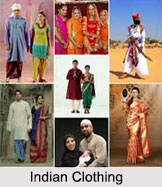 Indian Clothing is renowned throughout the world, for its ethnic wears, perfectly depicting the richness and exuberance of the cultural heritage. The Indian clothing style is considered as unique and exclusive. Indian clothing categorises separate dresses, depending on seasonal variations and geographical locations. Besides the traditional dresses, Indian clothing also includes various styles and patterns of western dresses and clothing styles. However, in the villages of India, traditional clothing like Kurta, Sarees, Lungi, Dhoti and Pyjama are more common. A lot of variations including regional as well as religion mark the styles of Indian clothing. A plethora of colours and textures in garments can be witnessed in Indian Clothing.
Indian Clothing is renowned throughout the world, for its ethnic wears, perfectly depicting the richness and exuberance of the cultural heritage. The Indian clothing style is considered as unique and exclusive. Indian clothing categorises separate dresses, depending on seasonal variations and geographical locations. Besides the traditional dresses, Indian clothing also includes various styles and patterns of western dresses and clothing styles. However, in the villages of India, traditional clothing like Kurta, Sarees, Lungi, Dhoti and Pyjama are more common. A lot of variations including regional as well as religion mark the styles of Indian clothing. A plethora of colours and textures in garments can be witnessed in Indian Clothing.
Indian Clothing for Men
The most familiar dress for Indian men is "Dhoti". It is basically a rectangular piece of unstitched fabric, usually 5 yards of length and is draped around the waist and the legs. Also known as "Veshti" in Tamil, "Laacha" in Punjabi, "Mundu" in Malayalam, "Pancha" in Telugu and "Dhotar" in Marathi, it has become a style mark for Indian men. In various regions of India, Dhoti is being worn with inimitable fashion. In northern region of India, the garment is usually worn with a "Kurta" on top. This combination is better known as "Dhoti-Kurta", or "Dhuti-Panjabi" in the eastern region. In southern part of the country, the garment is specially associated with wedding ceremonies and other joyous festivals. The participants of a South Indian Wedding, including the groom deck up in the traditional Pancha while performing the ceremonies. Silk Panchas are also known as "Magatam" or "Pattu Pancha" in several places of southern India. For Bengali grooms, off-white coloured Dhuti is very popular.
 Another dress which ennobles the wealth of Indian clothing is "Sherwani", which is basically a long jacket with buttons. The length of the Sherwani is generally up to the knee. It is usually worn in auspicious celebrations. Most Sherwanis are embroidered in various designs. Sometimes a long scarf is also used along with it.
Another dress which ennobles the wealth of Indian clothing is "Sherwani", which is basically a long jacket with buttons. The length of the Sherwani is generally up to the knee. It is usually worn in auspicious celebrations. Most Sherwanis are embroidered in various designs. Sometimes a long scarf is also used along with it.
"Lungi" is a particular type of cloth that is wrapped around the waists. This is a casual dress mainly worn by men at home. But now-a-days, the traditional dresses have been substituted with typical western wears like jeans, shirts, trousers, etc.
Indian Clothing for Women
The most popular traditional Indian clothing for women is "Saree". It is a long piece of cloth made from fine cotton, silk or other fabrics, weaving in different grains with different designs. The saree has a lasting charm, adding elegance and beauty of an Indian woman. There are variations in the method of wearing and wrapping the saree, which varies in different regions, based on the prevalent culture.
 Another popular attire of women in Indian clothing is the Indian Salwar-Kameez. In northern region of India, Salwar-Kameez is really very popular and in high demand. It is getting wide acceptance among Indian women in all the regions. Sometimes, instead of Salwar a woman often wear a Churidar.
Another popular attire of women in Indian clothing is the Indian Salwar-Kameez. In northern region of India, Salwar-Kameez is really very popular and in high demand. It is getting wide acceptance among Indian women in all the regions. Sometimes, instead of Salwar a woman often wear a Churidar.
Indian Clothing constitutes very colourful dresses, highlighting their magnificence and grandeur. Rajasthani and Gujarati women, especially, dress in multicoloured twirling skirts called "Lehenga", matching nicely with a short top called a "Choli". As a part of their traditional practices they cover their heads with beautiful veils, popularly known as "Odhani". India is an abode of various tribal communities. Each one of them dress up according to their own fashion and tradition, thus, enriching the trend of Indian clothing.
Indian Clothing varies according to religious and regional diversities. But with modernisation of the society, the younger generation is more prone to the western wear; and thus a new variation of Indian Clothing has evolved with the fusion of traditional Indian and modern western attires, giving it a rather unique and distinct identity. Indian clothing is as varied and enriched as the whole demographical variation of the country itself, keeping intact its originality and beauty.





















